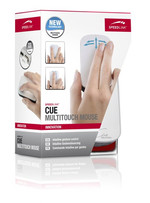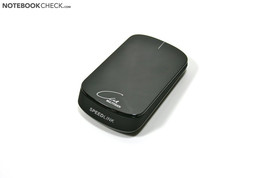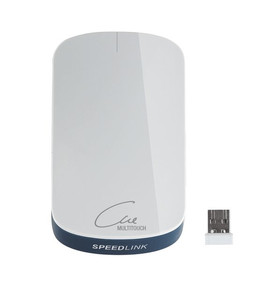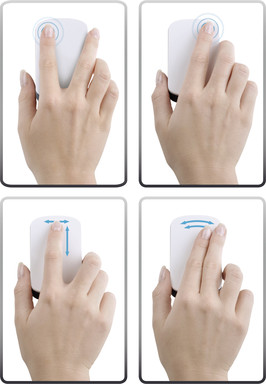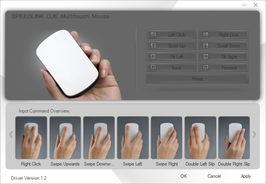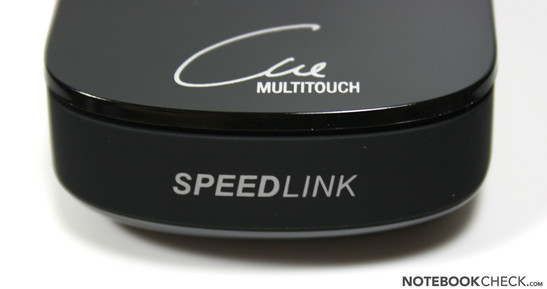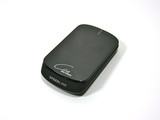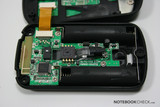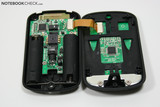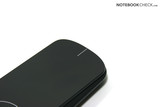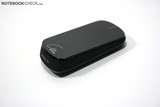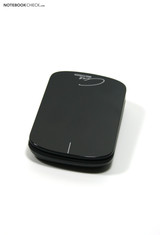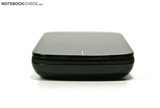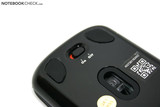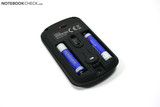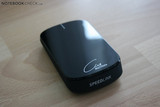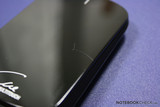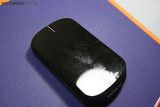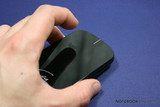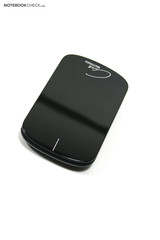Review Speedlink Cue Multitouch Mouse
Scope of Delivery
Beside the mouse, you find two (non-rechargeable) AAA batteries, one nano USB receiver, one short, multilingual installation guide and one mini CD with the driver software in the package.
Technical Specifications (according to Speedlink)
- Wireless mouse with sensor surface
- Multi-touch functions via finger gestures
- 1000 dpi optical sensor
- Max. range of 8 m thanks to 2.4 GHz wireless technology
- Compact nano receiver (not storable)
- Energy saving mode and on/off button
- Symmetrical design for right and left hand users
Design
The Cue Multitouch reminds of an external high-gloss touchpad. The design is plain and rounded edges dominate the silhouette. The mouse is suitable for both right and left handed users due to the symmetrical form. The Cue is available in black (in review), white, red and silver. The piano lacquered surface bids good gliding characteristics. In return, it's logically susceptible for fingerprints. Speedlink has integrated a rubber surface on the sides. The material quality is acceptable and there's no reason for complaint in view of manufacturing.
Operation
A feature of the Speedlink Cue is the multi-touch mouse pad on the mouse. It allows executing various gestures with one and two fingers. The sensor field is mainly used for vertical and horizontal scrolling and detecting if it's been clicked left or right. Scrolling over longer distances proves to be somewhat difficult due to the lack of inertial scrolling (acceleration as in the Magic Mouse or in current Mac Trackpads). The Cue can't link up with the Microsoft Arc Touch and Logitech Anywhere MX with an endless wheel in this respect.
A drawback that quickly becomes obvious is the missing detection at the edges. Especially the right click is often not recognized when the touchpad is pressed too far on its outside. Moreover, you also have to remove your left finger to execute a right click.
Buttons and gestures can be mapped freely with the basic Speedlink drivers. However, the two finger gestures will be modified at most and e.g. be assigned to a macro in practice. Unfortunately, new gestures can't be added and thus, only the 6 gestures remain, not including the mouse clicks.
The optical sensor works perfectly on mouse pads and wooden surfaces in the test. However, it has to capitulate on glass surfaces (unlike the Darkfield sensor in Anywhere's MX).
In order to spare the included batteries, the Cue quickly enters its sleep mode. It reawakes with a bit of delay which results in annoying waiting times. The mouse often even didn't reawake properly in the test and first worked again after unplugging and re-plugging the small nano receiver.
The Speedlink Cue wasn't convincing in the gaming test. Although the optical sensor is sufficiently precise, you quickly find yourself wishing for faster dedicated mouse buttons. The lack of ergonomics is quickly upsetting especially in office use. Consequently, we would recommend the Cue only for a short period of use.
Verdict
The Speedlink Cue attempts to make the successful concept of Apple's Magic Mouse available to PC users at a low price. Alike the Magic Mouse, the ergonomics suffer due to the design. The Cue is definitely not a palm-pleaser and, in our opinion, isn't suitable for hours of work.
Unfortunately, it doesn't have inertial scrolling like its Apple counterpart. Thus, only short scroll distances can be accomplished. Moreover, unrecognized clicks, due to the missing detection at the edges, are also a recurring problem. Additionally, the sleep mode with a long wake-up time is annoying. And sometimes the Cue even completely oversleeps.
Nevertheless, the Cue is apt for occasional mobile use due to its small size, lack of cables and low weight.
+ Small and light
+ Restricted functionality with Windows and Mac even without drivers
- Deactivates itself with Mac OS X during use (because no driver?)
- Needs long to wake up from sleep mode (sometimes not at all)
- Scrolling not as perfect as, e.g., on good touchpads
- Can't be used up to its edges
- Right mouse key is often not triggered (when left finger remains on pad)
- Un-ergonomic hand positioning





